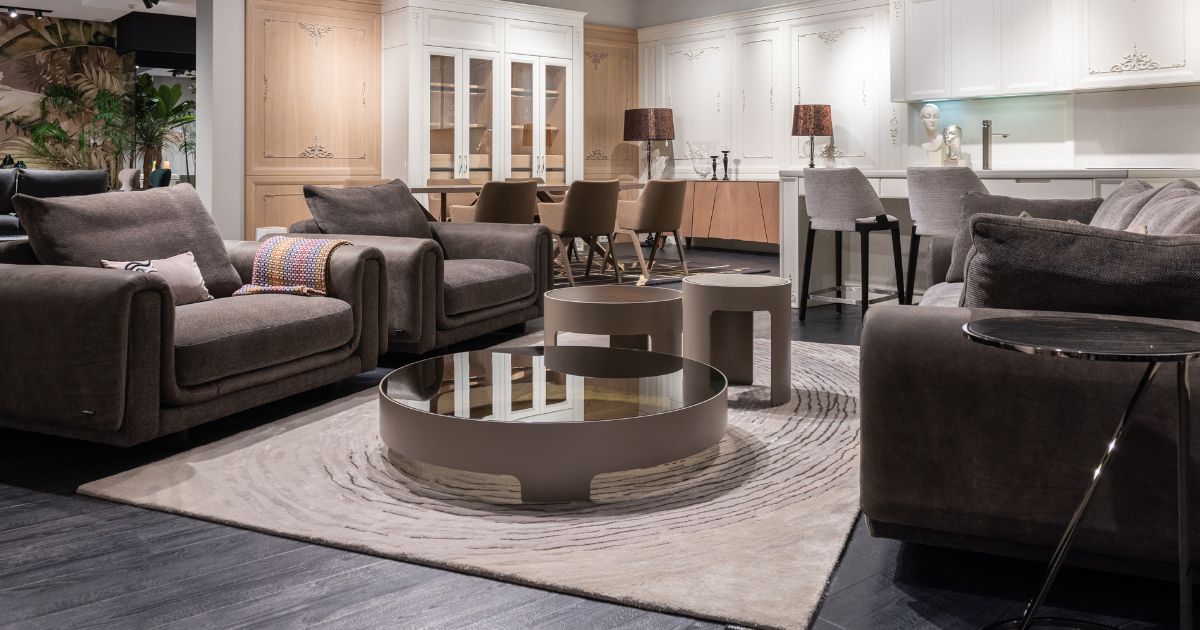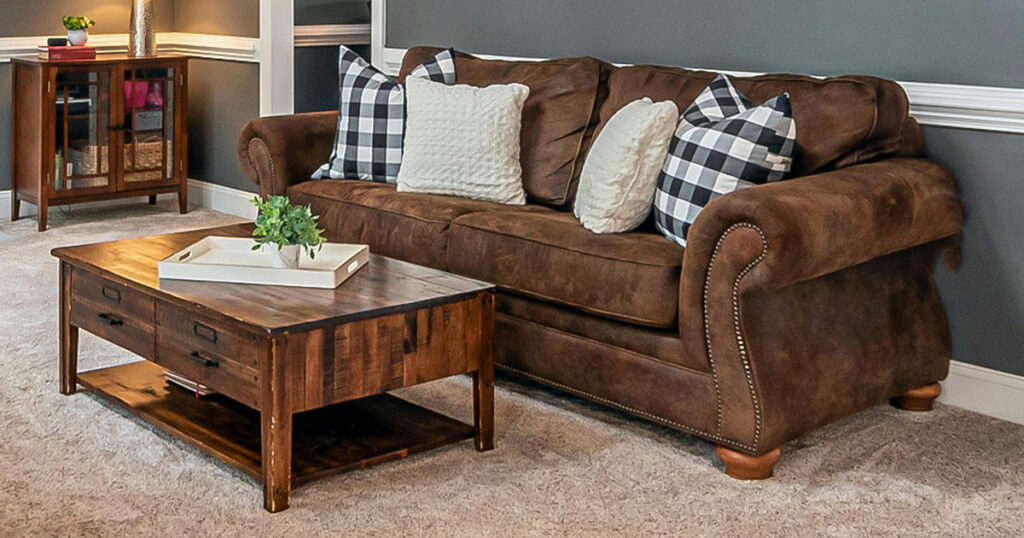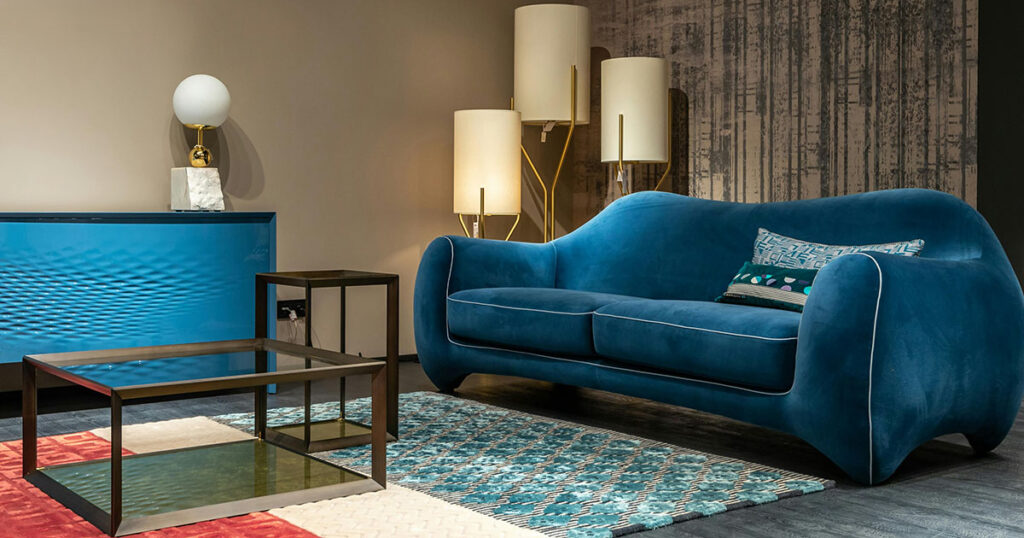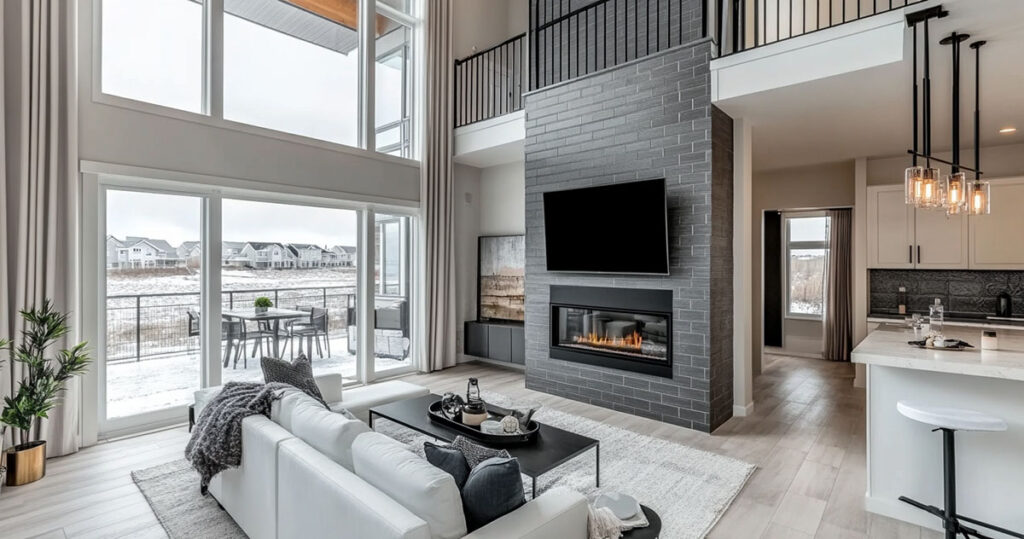Finding the right carpet or rug for your store is more than just picking a color.
It affects things from customer comfort to maintenance costs.
This comprehensive guide will walk you through the essential considerations.
Understanding Tufted Rugs and Carpets
Tufted rugs and carpets dominate the modern commercial market for good reason. Made by punching yarn through a backing material to form a pile, these floor coverings offer the perfect balance of aesthetics, durability, and cost-effectiveness.
What sets tufted carpets apart? They account for over 90% of commercial broadloom carpet production because the process creates durable, versatile textures while keeping costs manageable.
The construction involves pushing yarn through a primary backing (like a giant sewing machine), creating either loop pile (intact loops) or cut pile (sliced loops), securing with latex adhesive, and adding a secondary backing for stability.
The result is a versatile floor covering that can withstand commercial demands while offering design flexibility that other carpet types can’t match at the same price point.
Choosing the Right Rug Yarn
Your material choice dramatically affects performance, maintenance, and cost. Let’s explore the most common options for commercial spaces.
Wool: Premium Natural Performance
Wool offers a luxurious feel with practical benefits. Its natural resilience gives it a springy quality that helps fibers bounce back from compression, even under furniture. The inherent lanolin oils provide stain resistance without chemical treatments, while its flame retardance adds an element of safety. Wool also excels in color richness and depth, creating a visual warmth that synthetic options struggle to match.
Best suited for executive offices, high-end retail, boutiques, and spaces where premium aesthetics matter, wool typically costs $5-$15 per square foot for quality commercial-grade options, possibly higher for premium New Zealand wool. While naturally soil-resistant, wool requires prompt cleaning of spills to prevent absorption.
Nylon: The Commercial Standard
Nylon has earned its position as the workhorse of commercial carpeting through exceptional performance under pressure. Its superior resilience allows it to spring back from furniture indentations and heavy traffic, maintaining its appearance over time. When properly treated, nylon offers excellent stain resistance, making it practical for busy environments.
Available in virtually any color or texture, nylon provides versatility for branding and design needs. Solution-dyed options, where color runs throughout the fiber rather than just on the surface, resist fading and bleaching from cleaning or sunlight exposure.
Quality commercial nylon costs $3-$7 per square foot for the material alone. While more expensive than polyester or olefin, its longevity often results in better long-term value, especially in high-traffic retail floors, busy corridors, restaurant dining areas, and office spaces.
Polyester and Polypropylene: Specialized Applications
Polyester (PET) delivers superior color clarity and a vibrant appearance that can enhance retail environments where visual impact matters. Its natural stain resistance to water-based spills makes it practical for areas where beverages might be present. With a soft, plush feel compared to other synthetics and eco-friendly options made from recycled plastic bottles, polyester works well in moderate traffic areas like boutique fitting rooms or hotel guest rooms.
Polypropylene (olefin) offers exceptional stain and moisture resistance due to its hydrophobic nature. Liquids tend to bead on the surface rather than penetrate, making immediate cleanup easier. Its colorfast properties resist fading from cleaning or sunlight, while its budget-friendly pricing (typically $1-$3 per square foot) appeals to cost-conscious projects. These properties make polypropylene ideal for indoor-outdoor transition areas, cafés, entryways, and spaces where moisture resistance matters more than plushness.
Key Performance Considerations
Beyond material type, several factors determine how well a carpet will perform in your commercial space over time.
Dense, low-pile carpets resist crushing and show less dirt, making them ideal for busy retail aisles and high-traffic zones. These carpets maintain their appearance longer and require less intensive maintenance. While higher pile offers more comfort, it requires more frequent upkeep and will show traffic patterns sooner – a consideration for spaces where appearance consistency matters.
Loop pile (where the yarn forms uncut loops) generally outperforms cut pile in high-traffic areas due to its tighter construction. For visual interest without sacrificing durability, cut and loop combinations create texture and pattern while maintaining performance in busy areas. For retail stores and high-traffic areas, focus on products with pile heights under 0.5 inches and high pile density for maximum durability.
The backing system dramatically affects performance and longevity. Primary backing provides the foundation for tufts, while secondary backing adds dimensional stability and strength. Some products feature cushion backings that improve comfort and acoustic properties – a significant benefit in noisy retail environments. For areas prone to spills, moisture-barrier backings prevent liquid penetration into subfloors, protecting your investment beyond the carpet itself.
Commercial carpets typically come with wear ratings indicating appropriate traffic levels (light, moderate, heavy) and warranties covering wear, stains, and appearance retention. Quality commercial products often offer 7-10 year warranties, but understanding exactly what’s covered and what maintenance is required to maintain warranty coverage is essential before making a significant investment.
Installation Options for Commercial Spaces
Your installation method significantly impacts both performance and budget, with several approaches available depending on your specific needs.
For wall-to-wall broadloom, direct glue-down installation adheres carpet directly to the subfloor, providing a firm, stable surface that won’t shift or buckle. This method works well for spaces with rolling loads like shopping carts or office chairs and minimizes trip hazards at transitions. Installation costs typically add $1-$3 per square foot beyond material costs.
For enhanced comfort without sacrificing stability, double-glue installation involves gluing a cushion pad to the floor, then gluing the carpet to the pad. This combines stability with additional comfort and acoustic benefits at a higher installation cost, making it popular in upscale retail and hospitality settings where customer comfort enhances the experience.
Modular carpet tiles offer unique advantages for commercial spaces. Their design allows individual replacement of damaged or stained sections without replacing the entire floor. This targeted approach reduces installation waste (typically 3-4% versus 10-15% for broadloom) and simplifies handling in occupied spaces or buildings with limited access. Design flexibility comes through mixing colors, patterns, or installation directions, while simple access to underfloor systems proves valuable for spaces with frequent technological updates.
Installation options for carpet tiles include full-spread adhesive for permanent installation, releasable adhesive for easier future replacement, adhesive dots or tabs for faster installation, or free-lay systems with non-slip backing in limited applications. Carpet tiles typically cost $2-$11 per square foot for materials, with installation adding $1-$2 per square foot.
For maximum design flexibility, consider loose-laid area rugs with appropriate underlay for safety, inset carpets (carpet installed within borders of another flooring), or custom shapes and sizes to fit unique spaces or create branded areas. Though custom installations may increase costs by 25-50%, they create distinctive spaces that enhance brand identity and customer experience.
Practical Benefits
Tufted carpets offer substantial practical advantages beyond aesthetics that directly impact customer experience and operational efficiency.
Sound Management in Busy Spaces
In busy commercial environments, noise control creates a more pleasant atmosphere for both customers and staff. Carpets reduce sound reflection by 25-34 decibels (compared to 1-6 dB for hard surfaces), making a significant difference in ambient noise levels. The reverberation time in carpeted rooms is roughly half that of rooms with hard flooring, reducing the chaotic echo effect that can make spaces feel stressful and uncomfortable.
This acoustic improvement enhances speech intelligibility in carpeted spaces, allowing conversations to happen without shouting. Background music remains pleasant rather than overwhelming, and the overall environment feels more controlled and intentional. For retail environments where customer comfort influences browsing time and buying decisions, this acoustic benefit translates directly to the bottom line.
Specialized acoustic backing systems can further enhance sound absorption by up to 30%, making them worth considering for particularly noisy environments or multi-level spaces where sound transfer between floors might disrupt different departments or businesses.
Safety and Comfort Advantages
The physical properties of carpet create tangible benefits for safety and comfort. The slip resistance significantly reduces fall risks compared to hard surfaces, especially when moisture might be present from weather or spills. This protective quality becomes even more valuable in areas frequented by elderly customers or in climates where tracking in rain or snow is common.
When falls do occur, carpet’s cushioning effect minimizes injury severity compared to hard surfaces – a consideration that can have liability implications beyond the immediate concern for customer welfare. Staff who stand for extended periods experience reduced fatigue on carpeted surfaces, potentially improving service quality and employee satisfaction.
From a practical standpoint, merchandise dropped on carpet is less likely to break, reducing damage and loss. The thermal comfort carpet provides – warmer underfoot in cold weather – creates a more welcoming environment in winter months, encouraging customers to linger and explore your offerings rather than rushing through an uncomfortably chilly space.
Maintenance Reality
While carpet offers many advantages, proper maintenance remains essential for long-term performance. Daily vacuuming in high-traffic retail areas and weekly vacuuming in moderate-traffic zones removes abrasive particles that would otherwise damage fibers. Professional deep cleaning every 6-12 months (depending on traffic) prevents soil buildup and refreshes appearance.
Establishing protocols for immediate spot cleaning of spills, including having appropriate supplies readily available, prevents permanent staining and extends carpet life. Periodic inspection for seam issues or damage allows early intervention before problems spread, particularly in high-stress areas like pivoting points, cash wraps, or door transitions.
Factor these maintenance needs into your total ownership calculation—a quality carpet with proper maintenance will significantly outperform a cheaper option with inadequate care, often justifying the higher initial investment through extended useful life and better appearance retention.
Customization and Branding
One of tufted carpet’s greatest strengths is its ability to help create branded environments that reinforce your company’s identity and enhance customer experience.
Creating Signature Spaces
Inset logos in broadloom installations create permanent branding at key touchpoints like entrances and reception areas. For flexibility, custom tufted logo rugs can be positioned at entrances and other key areas, making them easy to update with rebranding or seasonal messaging. Multi-level tufting creates dimensional logos with varied pile heights, adding subtle sophistication to your branded elements.
Beyond logos, color-matched brand palettes throughout your space create cohesive environments that reinforce brand recognition. A professionally produced custom logo rug typically starts around $500 for small sizes (4’x6′) and increases based on size, complexity, and materials.
Custom color-matching to brand standards ensures perfect alignment with your other branded elements, though this typically requires minimum order quantities. Exclusive patterns that reflect brand identity can be developed for larger installations, creating a signature environment customers will associate only with your business.
Practical benefits come from using carpet design for zone definition through color changes (distinguishing checkout areas, fitting rooms, or different departments) and incorporating wayfinding elements built into the carpet design itself. These functional design elements improve customer navigation while reinforcing your brand’s attention to detail.
Custom color developments typically require a minimum of 500-1000 square yards for broadloom or 1000+ square feet for carpet tiles, making them more practical for larger installations or multi-location rollouts where consistency matters.
Current Innovations Worth Considering
The carpet industry continues to evolve with innovations that enhance performance, sustainability, and design options for commercial spaces.
Bold colors and patterns are making a comeback after years of neutral dominance, creating opportunities for more distinctive commercial spaces. Biophilic designs mimicking natural textures and organic patterns connect indoor spaces with nature, supporting well-being for customers and staff alike. Mixed-media looks combining hard and soft surface aesthetics allow carpet to integrate seamlessly with other flooring types, while modular shapes beyond squares (including hexagons, planks, and triangles) create distinctive floor patterns.
Performance innovations include enhanced stain-resistance technologies that allow even red wine to be cleaned with water – a game-changer for hospitality and retail spaces serving beverages. Antimicrobial treatments inhibit bacteria and mold growth, addressing both health concerns and odor prevention in busy commercial environments. Solution-dyed fibers provide unprecedented colorfastness, maintaining appearance even with frequent cleaning or sun exposure, while moisture-barrier backings prevent spills from reaching subfloors, protecting your overall building investment.
Sustainability advancements include carpets with recycled content (some featuring 100% recycled yarn) that reduce environmental impact without sacrificing performance. Carbon-negative options sequester more carbon than produced during manufacturing, supporting environmental commitments beyond basic recycled content.
PVC-free backings reduce environmental impact throughout the product lifecycle, while recyclable single-polymer constructions support closed-loop manufacturing for end-of-life reclamation. Take-back programs from major manufacturers simplify responsible disposal when replacement eventually becomes necessary.
Making Your Final Selection
When making your final decision, consider traffic patterns throughout your space, mapping high, medium, and low traffic zones to match materials accordingly. Analyze performance requirements based on rolling loads, spill likelihood, and your maintenance capacity to ensure the carpet can withstand your specific challenges.
Aesthetic alignment with your brand identity and interior design creates cohesive spaces that support your marketing goals, while budget reality requires balancing initial cost against expected lifespan for true value assessment. Installation timeline considerations should include potential business disruption, especially for existing operations needing to remain functional during updates.
Be honest about your maintenance capabilities, ensuring you have resources for proper upkeep of whatever carpet you select. If advanced maintenance isn’t practical, choose more forgiving options rather than high-maintenance carpets that will disappoint over time. For businesses with environmental commitments, select carpets that align with your sustainability goals, whether focused on recycled content, reduced chemical usage, or end-of-life reclamation.
Request samples large enough (at least 12″x12″) to properly evaluate in your actual space under your lighting conditions. View them at different times of day and from different angles to ensure the appearance remains consistent under all conditions your space experiences.
Need Rugs for Your Store?
Need expert guidance tailored to your specific commercial environment?
Contact us today for a free consultation.
Our specialists can help you navigate the options and find the perfect flooring solution for your needs.




